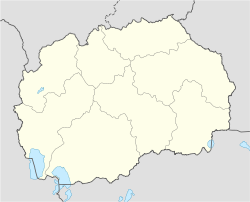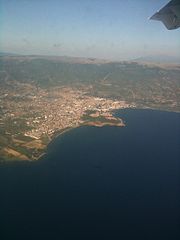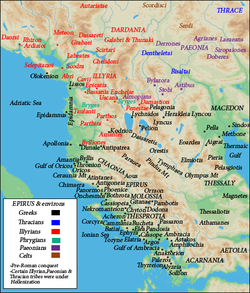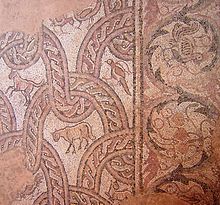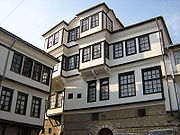- Ohrid
-
Coordinates: 41°07′01″N 20°48′06″E / 41.11694°N 20.80167°E
Ohrid
ОхридOhrid and Lake Ohrid 
FlagNickname(s): Balkan Jerusalem[1]
European Jerusalem[2]Location in the Republic of Macedonia Coordinates: 41°07′01″N 20°48′06″E / 41.11694°N 20.80167°E Country  Republic of Macedonia
Republic of MacedoniaMunicipality Ohrid Municipality Government – Mayor Aleksandar Petreski Area – Total 383.93 km2 (148.2 sq mi) Elevation +695 m (2,280 ft) Population (2002) – Total 42,003 – Density 142.97/km2 (370.3/sq mi) Time zone CET (UTC+1) Postal codes 6000 Area code(s) 389 46 Patron saints Saint Clement and Saint Naum Ohrid (Macedonian: Охрид [ˈɔxrit] (
 listen)) is a city on the eastern shore of Lake Ohrid in the Republic of Macedonia. It has about 42,000 inhabitants, making it the seventh largest city in the country. The city is the seat of Ohrid Municipality. Ohrid is notable for having once had 365 churches, one for each day of the year and has been referred to as a "Jerusalem".[3][4] The city is rich in picturesque houses and monuments, and tourism is predominant. It is located southwest of Skopje, west of Resen and Bitola, close to the border with Albania. In 1979 and in 1980, Ohrid and Lake Ohrid were accepted as a Cultural and Natural World Heritage Sites by UNESCO. In fact, Ohrid is one of only 28 sites that are part of UNESCO's World Heritage that are both Cultural and Natural sites.[5]
listen)) is a city on the eastern shore of Lake Ohrid in the Republic of Macedonia. It has about 42,000 inhabitants, making it the seventh largest city in the country. The city is the seat of Ohrid Municipality. Ohrid is notable for having once had 365 churches, one for each day of the year and has been referred to as a "Jerusalem".[3][4] The city is rich in picturesque houses and monuments, and tourism is predominant. It is located southwest of Skopje, west of Resen and Bitola, close to the border with Albania. In 1979 and in 1980, Ohrid and Lake Ohrid were accepted as a Cultural and Natural World Heritage Sites by UNESCO. In fact, Ohrid is one of only 28 sites that are part of UNESCO's World Heritage that are both Cultural and Natural sites.[5]Contents
Name
See also: Names of European cities in different languages: M-P#OIn Macedonian and the other South Slavic languages, the name of the city is Ohrid (Охрид). In Albanian, the city is known as Ohër or Ohri. Historical names include the Latin Lychnidus[6] or the Greek names Lychnidos (Λύχνιδος), Ochrida (Οχρίδα, Ωχρίδα) and Achrida (Αχρίδα), the latter two of which are still in modern usage.
Geography
Ohrid is located in the south-western part of Macedonia, on the banks of Lake Ohrid, at an elevation of 690 meters above sea level.
History
Ancient
The earliest inhabitants of the widest Lake Ohrid region were tribes of disputable Illyrian origin, the Dassaretae and Encheleans.[7] According to recent excavations by Macedonian archaeologists it was a town way back at the time of king Phillip II of Macedon.[8] They allege that Samuil's Fortress was built on the place of an earlier fortification, dated to 4th century B.C.[8] During the Roman conquests, towards the end of 3rd and the beginning of 2nd century BC, the Dassaretae and the region Dassaretia were mentioned, as well as the town of Lychnidos. The existence of the ancient town of Lychnidos is linked to the Greek myth of the Phoenician prince Cadmus who, banished from Thebes, in Boetia, fled to the Enchelei[9] and founded the town of Lychnidos on the shores of Lake Ohrid.[10] The Lake of Ohrid, the ancient Lacus Lychnitis, whose blue and exceedingly transparent waters in remote antiquity gave to the lake its Greek name; it was still called so occasionally in the Middle Ages. It was located along the Via Egnatia, which connected the Adriatic port Dyrrachion (present-day Durrës) with Byzantium. Archaeological excavations (e.g., the Polyconch Basilica from 5th century) prove early adoption of Christianity in the area. Bishops from Lychnidos participated in multiple ecumenical councils.
Medieval
 The Annunciation from Ohrid, one of the most admired icons of the Paleologan Mannerism from the Church of St. Climent.
The Annunciation from Ohrid, one of the most admired icons of the Paleologan Mannerism from the Church of St. Climent.
The South Slavs begun to arrive in the area during the 6th century AD. Until the early 7th century it was colonized by the tribe of Berziti. The Bulgars conquered the city in 867. The name Ohrid first appeared in 879. Between 990 and 1015, Ohrid was the capital and stronghold of the Bulgarian Empire.[11] From 990 to 1018 Ohrid was also the seat of the Bulgarian Patriarchate. After the Byzantine reconquest of the city in 1018 by Basil II, the Bulgarian Patriarchate was downgraded to an Archbishopric and placed under the authority of the Ecumenical Patriarch of Constantinople.
The higher clergy after 1018 was almost invariably Greek, including during the period of Ottoman domination, until the abolition of the archbishopric in 1767. At the beginning of the 16th century the archbishopric reached its peak subordinating the Sofia, Vidin, Vlach and Moldavian eparchies, part of the former Serbian Orthodox Peć Patriarchate (including Peć itself), and even the Orthodox districts of Italy (Apulia, Calabria and Sicily), Venice and Dalmatia.
As an episcopal city, Ohrid was an important cultural center. Almost all surviving churches were built by the Byzantines and by the Bulgarians, the rest of them date back to the short time of Serbian rule during the late Middle Ages.
Bohemond leading an Norman army took the city in 1083. In the 13th and 14th century the city changed hands between the Despotate of Epirus, the Bulgarian, the Byzantine and the Serbian Empire and local Albanian rulers. In the middle of the 13th century Ohrid was one of the cities ruled by Paul Gropa, a member of the Albanian noble Gropa family.[12] In 1334 the city was captured by Stefan Uroš IV Dušan and incorporated in the Serbian Empire.[13] After Dusan's death the city came under the control of Andrea Gropa, while after his death Prince Marko incorporated it in the Kingdom of Prilep.[14] In the early 1370s Marko lost Ohrid to Paul II Gropa, another member of the Gropa family and unsuccessfully tried to recapture it in 1375 with Ottoman assistance.[15] In 1395 the Ottomans under Bayezid I captured the city. In September 14-5, 1464 12,000 troops of the League of Lezhë and 1,000 of the Republic of Venice defeated a 14,000-man Ottoman force near the city.
Modern
The Christian population declined during the first centuries of Ottoman rule. In 1664 there were only 142 Christian houses. The situation changed in the 18th century when Ohrid emerged as an important trade center on a major trade route. At the end of this century it had around five thousand inhabitants. Towards the end of the 18th century and in the early part of the 19th century, Ohrid region, like other parts of European Turkey, was a hotbed of unrest. In the 19th century the region of Ohrid became part of the Pashalik of Scutari, ruled by the Bushati family.[16] By the end of 19th century Ohrid had 2409 houses with 11900 inhabitants out of which 45% were Muslims while the rest was mainly Roman Catholic and Orthodox Christian. Before 1912, Ohrid was a township center bounded to Monastir sanjak in Monastir province (present-day Bitola). The city remained under the Ottomans until 1912, when the Serbian army took control of the city. In September 1913 local Albanian and Internal Macedonian Revolutionary Organization leaders rebelled against the Kingdom of Serbia.
Main sights
Natural and Cultural Heritage of the Ohrid region * UNESCO World Heritage Site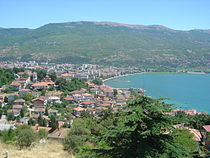
Country  Republic of Macedonia
Republic of MacedoniaType Mixed Criteria i, iii, iv, vii Reference 99 Region ** Europe and North America Inscription history Inscription 1979 (3rd Session) Extensions 1980 * Name as inscribed on World Heritage List
** Region as classified by UNESCOThere is a legend supported by observations by Ottoman traveler from 15th century Evliya Çelebi that there were 365 chapels within the town boundaries, one for every day of the year. Today this number is significantly smaller. However during the medieval times, Ohrid was called "Slavic Jerusalem".[17]
- Church of St. Sophia
- Church of St. Panteleimon
- Church of St. John at Kaneo
- Church of St. Clement
- Church of St. George
- Church of St. Zaum
- Monastery of St. Naum
- Church of St. Petka
- Church of St. Stefan
- Vestiges of basilicas from the early-Christian time, e.g. Basilica of St. Erazmo (4th century)
- Museum of Slavic writing culture (18th century)
- Robevi family house, museum of archeology
- Ancient Theatre of Ohrid
- Church of St. Vrači, with frescos from the 14th century. A 14th-century icon from the church is depicted on the obverse of the Macedonian 1000 denars banknote, issued in 1996 and 2003.[18]
Besides being a holy center of the region, it is also the source of knowledge and pan-Slavic literacy. The restored Monastery at Plaošnik was actually one of the oldest Universities in the western world, dating before the 10th century.
Transportation
There is a nearby airport, Ohrid Airport (now known as Apostle Paul Airport) that is open all year round.
Recurring events
- Ohrid Summer Festival, annual theater and music festival from July to August
- Ohrid Choir Festival, annual international choir festival in the end of August
- The Balkan Festival of Folk Songs and Dances, annual folklore music and dance festival in the beginning of July
- Balkan music square festival, music festival in August in which ethno musicians from the whole Balkan peninsular participate
- Ohrid Fest (Охридски Трубадури), music festival in August in which musicians from the whole Balkan peninsular are participating. This festival is held for four days which are divided into (Debutant Night, Folk Night, Pop Night and International Night).
International relations
See also: List of twin towns and sister cities in MacedoniaTwin towns — Sister cities
Ohrid is twinned with:
 Budva, Montenegro
Budva, Montenegro Katwijk, Netherlands
Katwijk, Netherlands Kragujevac, Serbia
Kragujevac, Serbia Patras, Greece
Patras, Greece
 Safranbolu, Turkey
Safranbolu, Turkey Seongnam, South Korea
Seongnam, South Korea Veliko Tarnovo, Bulgaria
Veliko Tarnovo, Bulgaria Vinkovci, Croatia
Vinkovci, Croatia
 Windsor, Canada
Windsor, Canada Wollongong, Australia
Wollongong, Australia Yalta, Ukraine
Yalta, Ukraine Zemun, Serbia
Zemun, Serbia
Gallery
-
The Church of St. John at Kaneo high above the lake
See also
- List of people from Ohrid
- Ohrid Agreement
- Archbishopric of Ohrid
- List of archbishops of the Archbishopric of Ohrid
- Orthodox Ohrid Archbishopric
Notes
- ^ Press online Gradovi u jesen (Serbian)
- ^ Dnevnik newspaper - Interview with the ambassador of Israel to Macedonia (Macedonian)
- ^ Between past and future: civil-military relations in post-communist Balkan states, Biljana Vankovska, Håkan Wiberg, I.B.Tauris, 2003, ISBN 1-86064-624-7, p. 71.
- ^ "The Mirror of the Macedonian Spirit, Zlate Petrovski, Sašo Talevski, Napredok, 2004, ISBN 978-9989-730-38-2, page 72: "... and Macedonia in the Cathedral Church St. Sofia in the Macedonian Jerusalem — Ohrid..."
- ^ Natural and Cultural Heritage of the Ohrid region
- ^ Wilkes, J. J. The Illyrians, 1992,ISBN 978-0-631-19807-9,Page 273: "... The provincial capital Scodra and Dyrrhachium were seats of the metropolitans, and there were bishops at Lissus, Doclea, Lychnidus (Ohrid),
- ^ Aufstieg und Niedergang der römischen Welt: Geschichte und Kultur Roms im Spiegel der neueren Forschung, Hildegard Temporini, Wolfgang Haase, Walter de Gruyter, 1983, ISBN 3110095254, p. 537.
- ^ a b "Culture — Republic of Мacedonia". www.culture.in.mk. http://www.culture.in.mk/story.asp?id=12676. Retrieved 2008-10-13.
- ^ Wilkes, J. J. The Illyrians, 1992,ISBN 978-0-631-19807-9,page 98,"the Illyrian Enchelei, the 'eel-men', whose name points to a location near Lake Ohrid"
- ^ Wilkes, J. J. The Illyrians, 1992,ISBN 978-0-631-19807-9,Page 99:"... 99 victory would be theirs if they received Cadmus as king. After this had come about as foretold, Cadmus and Harmonia ruled over them and founded the towns of Bouthoe (Budva) and Lychnidus (Ohrid). ..."
- ^ Old Hermit's Almanac by Edward Hays,1997,ISBN 978-0-939516-37-7,page 82: "... He sent word to Samuel, the ruler in the Bulgarian capital of Ohrid, that he was returning 15,000 of his prisoners of war. ..."
- ^ Lala, Etleva; Gerhard Jaritz (2008). "Regnum Albaniae and the Papal Curia". Central European University. p. 59. http://www.etd.ceu.hu/2009/mphlae01.pdf. Retrieved 3 February 2011.
- ^ Dobson, Richard Barrie (2000). Encyclopedia of the Middle Ages. Editions du Cerf. p. 1044. ISBN 9781579582821. http://books.google.com/books?id=om4olQhrE84C&pg=PA1044. Retrieved 19 April 2011.
- ^ Soulis, George Christos (1984). The Serbs and Byzantium during the reign of Tsar Stephen Dušan (1331-1355) and his successors. Dumbarton Oaks Library and Collection. p. 142. ISBN 9780884021377. http://books.google.com/books?id=NXFpAAAAMAAJ&q=%22andrew+gropa%22&dq=%22andrew+gropa%22&hl=en&ei=5T2pTd7wLMLqOZfblckJ&sa=X&oi=book_result&ct=result&resnum=1&ved=0CCcQ6AEwAA. Retrieved 16 April 2011.
- ^ Tsvetkov, Plamen S. (1993). A history of the Balkans: a regional overview from a Bulgarian perspective. EM Text. p. 219. ISBN 9780773419568. http://books.google.com/books?id=VR5pAAAAMAAJ. Retrieved 19 April 2011.
- ^ Iseni, Bashkim (2008). La Question Nationale En Europe Du Sud-Est: Genese, Emergence Et Developpement de L'Identite Nationale Albanaise Au Kosovo Et En Macedoine. Peter Lang. p. 120. ISBN 9783039113200. http://books.google.com/books?id=gAdlqwCm_9sC&pg=PA120. Retrieved 23 December 2010.
- ^ City of Ohrid official web portal
- ^ National Bank of the Republic of Macedonia. Macedonian currency. Banknotes in circulation: 1000 Denars (1996 issue) & 1000 Denars (2003 issue). – Retrieved on 30 March 2009.
External links
- The Pearls of Ohrid
- e-Ohrid Portal (Macedonian)
- Ohrid travel guide from Wikitravel
- Ohrid including information in English
- Ohrid Lake Macedonia 1958 - Kinoteka na Makedonija Ohridsko Ezero
- Municipality of Ohrid
- Ohrid Saint Paul the Apostole Airport
- Ohrid News
- "Ohrid Climate Guide". http://www.weather2travel.com/climate-guides/index.php?destination=ohrid.
- Attribution
 This article incorporates text from a publication now in the public domain: Herbermann, Charles, ed (1913). "Achrida". Catholic Encyclopedia. Robert Appleton Company.
This article incorporates text from a publication now in the public domain: Herbermann, Charles, ed (1913). "Achrida". Catholic Encyclopedia. Robert Appleton Company.

Landmarks Churches Sports Education University for Information Science and Technology • Institute for Protection of Cultural Monuments and National MuseumEvents Balkan Folklore Festival • Colony Ramazzoti • Ohrid Choir Festival • Ohrid Fest • Ohrid Summer Festival • Ohrid Swimming MarathonTransportation Ohrid St. Paul the Apostle AirportPeople Cities Ohrid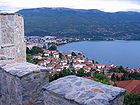
Villages Dolno Lakočerej • Elšani • Elešec • Gorno Lakočerej • Konjsko • Kosel • Kuratica • Lagadin • Leskoec • Livoišta • Ljubaništa • Openica • Orman • Peštani • Plakje • Rača • Ramne • Rasino • Rečica • Sirula • Skrebatno • Sveti Stefan • Sviništa • Šipokno • Trpejca • Vapila • Velestovo • Velgošti • ZavojCities and towns in the Republic of Macedonia Berovo · Bitola · Bogdanci · Debar · Delčevo · Demir Hisar · Demir Kapija · Gevgelija · Gostivar · Kavadarci · Kičevo · Kočani · Kratovo · Kriva Palanka · Kruševo · Kumanovo · Makedonska Kamenica · Makedonski Brod · Negotino · Ohrid · Pehčevo · Prilep · Probištip · Radoviš · Resen · Skopje · Struga · Strumica · Sveti Nikole · Štip · Tetovo · Valandovo · Veles · Vinica
Historical Capitals of Bulgaria Categories:- Former capitals of Bulgaria
- Cities in the Republic of Macedonia
- Archaeological sites in the Republic of Macedonia
- World Heritage Sites in the Republic of Macedonia
- Ohrid
- Greek colonies in Illyria
Wikimedia Foundation. 2010.


